Studies
Higher education in the field of Arts Studies, as they operate within the unique model of art schools, constitute one of the major issues in today’s world. They are to be found at the intersection of three major currents which inform both present time and times to come.
1. The growing importance of the image, and more generally the sensitive, in contemporary society
2. The growing importance attributed by the financial sector and more widely by society, to the values and processes emanating from the art world.
3. The importance of notions of independence, of the project and of professionalization in the field of training
++ DEGREES IN PUBLIC
POSTSECONDARY SCHOOLS
OF ART AND DESIGN
OPTIONS / SPECIALITIES
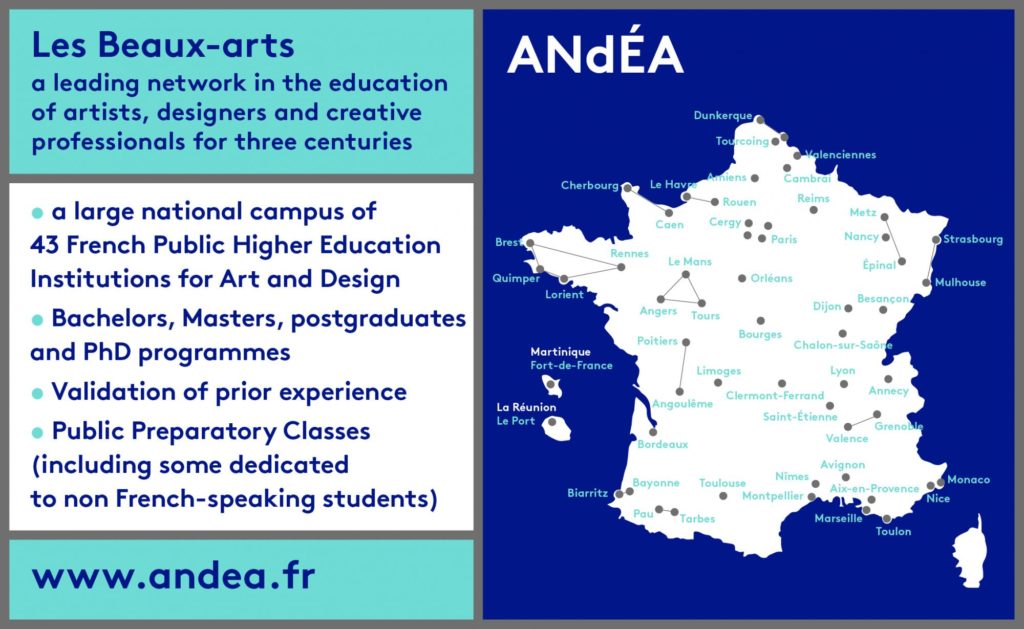

The architecture of studies and qualifications
There are in France 43 higher schools of art under the pedagogical supervision of the Ministry for Culture and Communication, located in 56 sites all over the country. In most of these schools, studies are constructed in the following manner:
_a first cycle leading to a national qualification, a Diplôme National d’Art (DNA), of a “Licence-Bachelor” level (semesters 1 to 6) made up of a general first year and two years in one of the following three options: art, design or communication;
_a second cycle leading to a national qualification, the Diplôme National Supérieur d’Expression Plastique / National Higher Degree in Visual Expression (DNSEP), in art, design or communication, awarding the grade of Master (semesters 7 to 10).
_Some schools offer third cycles or postgraduate courses, that may, or may not, lead to school qualifications, and university 3rd cycles (PhD in collaboration with partner universities) leading to a Doctoral degree.
Four schools in the network award specific establishment certificates: the three parisian national higher schools (ENSBA, ENSAD and ENSCI) and Le Fresnoy – the National Studio of Contemporary Arts in Tourcoing.
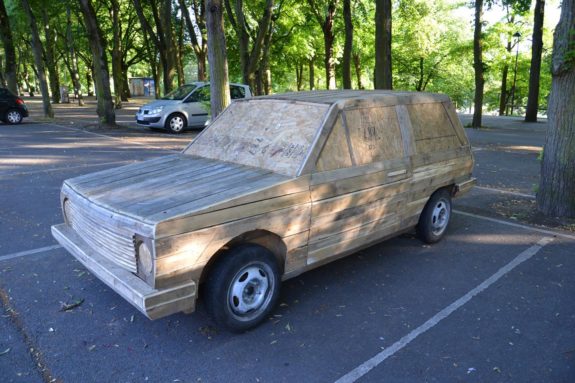
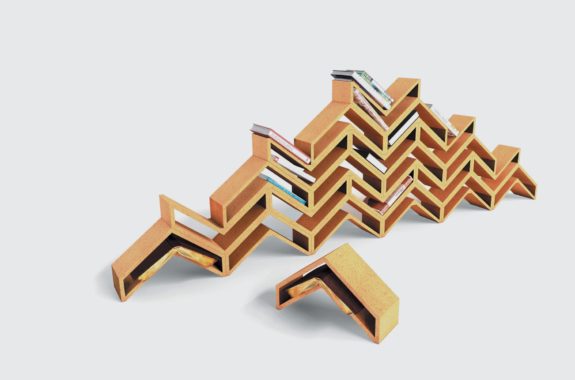

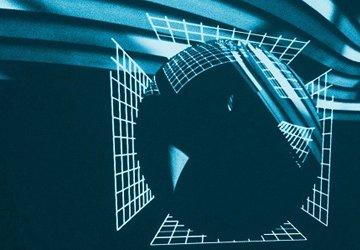
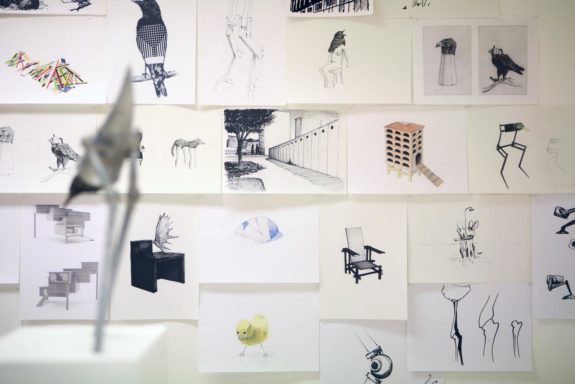
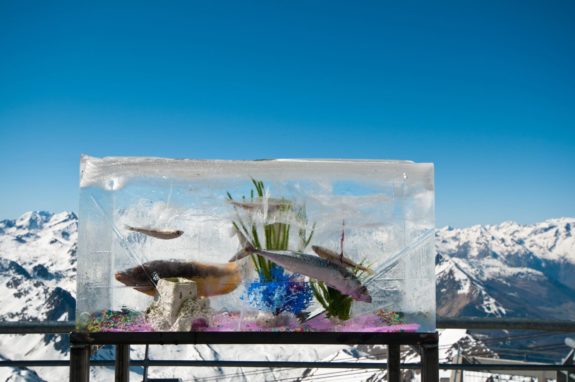
Baptiste Brévart, DNSEP 2012, Ensa Bourges
École nationale supérieure d’art de Nancy
École européenne supérieure d’art de Bretagne | site Brest
Pavillon Bosio – École supérieure d’arts plastiques de la ville de Monaco
École supérieure d'art des Pyrénées — Site de Tarbes
Competitions and commissions
Entry to the first year in a higher school of art is made through an entry competition. Students are chosen following an examination open to all secondary level students having successfully passed the Baccalauréat (or an equivalent qualification in the case of foreign students). Exceptions can be made for students without a Baccalauréat. The admission exam is organized in two phases:
_a first phase composed of the following three elements: artistic practice, general culture, foreign language skills;
_a second, decisive phase made up of an interview with an admissions panel based on the candidates artistic portfolio.
The organization of the competition – and the modalities of admission – are decided by each school. Admissions mid curriculum are made through internal panels of equivalence in each establishment.
The applicants are present in May (1st session) and in September (2nd session) for an entrance exam, in June (1st session) and in September (2nd session) for admissions and equivalences committees.
Admissions Commission
The admissions commission receives students who have already completed one or more years of study in a Higher Education art school under the responsibility of the Minister for Culture. The entrance into a year where the curriculum is already underway, is validated by a committee made up of teachers from the school where the candidate is presenting his/her portfolio of work. It is essential for the candidate to have obtained the full number of ECTS credits for the previous years.
Commission for equivalences
The Commission for equivalences is for French students registered in a curriculum other than that of a higher art school and for foreign students who have already begun their studies in a country other than France. For foreign applicants, the portfolio must be translated into French and certified. The definitive admission of applicants is the decision of the Minister for Culture.
ECTS Credits
The Bologna Process (1999) that aimed to harmonize education on a European level has led schools to establish independent structures and to conform to the European architecture of higher education. Teaching is organized in semesters and validated by ECTS credits (European Credits Transfer System) recognized throughout the European Union. The DNSEP awards the grade of Master. In the framework of the harmonization of qualifications on a European level, the ECTS system allows for the movement of students from one country to another. It is centered on the academic path of the student and the evolution of his / her work organized by semester. The ECTS credits are attributed, by the ensemble of the teachers, to each element of the study programme: classes, practical work, tutorial classes, projects, internships, personal work, dissertation… both the fundamental teaching, along with the personal work that the student is expected to provide, are taken into account.
43 French Public higher schools of art and design
A large national campus
HOW TO APPLY?
1. Consult the list of 43 schools: you will find here a search engine allowing a multi-criteria prospecting
2. Select schools that interest you
3. Contact institutions preferably before February if you want to start in September to find out precisely how to apply (the deadlines, the documents to send…)
4. Or apply via www.campusart.org before February if you have already validated 3 years in a higher education institution and particularly if you are an applicant from a non-EU country (Campus Art gives access to advisers, single form and visa facilitation…)
There are also classes or training specially dedicated to foreign students and non French speakers in particular, that combine French language classes and preparation for art school entrance exams:
– Esad Saint Etienne
– Beaux-arts de Nantes
– Esa Dunkerque/Tourcoing
– Ensba Lyon
Resources
➔ « Of Design in Art » by Catherine Geel, 58e Salon de Montrouge, 2013
➔ « Teaching Art » by Bernhard Rüdiger, 58e Salon de Montrouge, 2013
➔ Charters for studies and research in art schools, 2014
➔ French public higher art schools: studies, programmes and qualifications, 2014